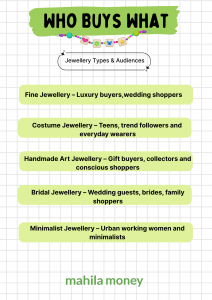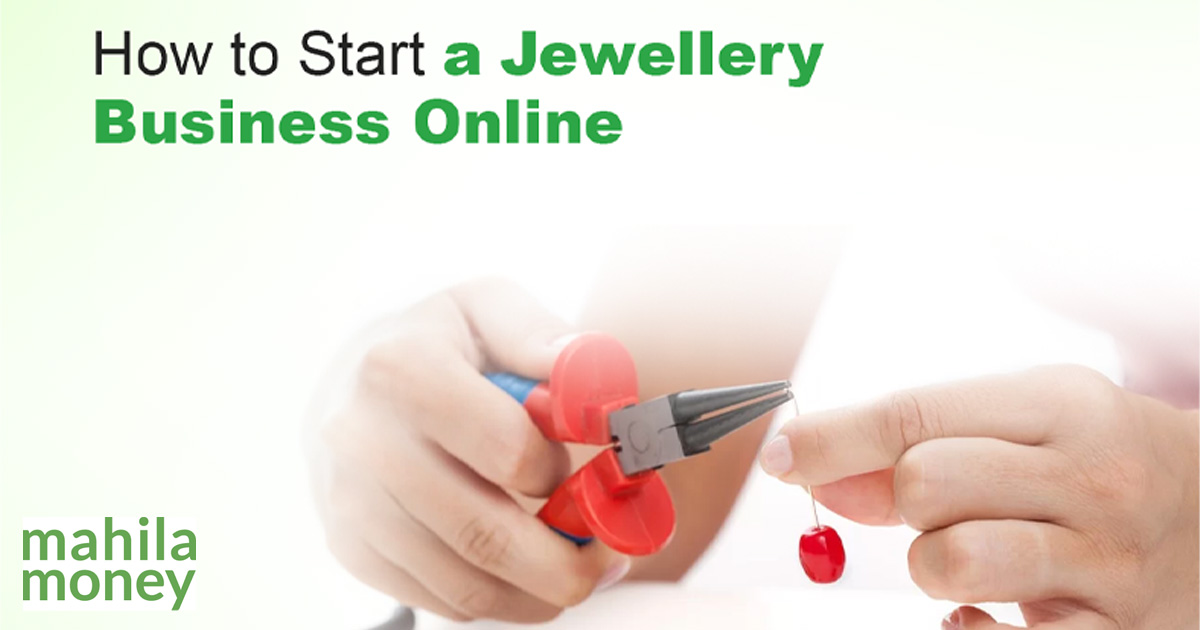Jewellery has always been personal in India, from oxidised jhumkas at a street fair to heirloom bridal sets; every piece tells a story. Today, many women are turning that passion into profit. With low investment, creative freedom, and digital tools at your fingertips, learning how to start a jewellery business online is more accessible than ever.
India’s jewellery market is booming. The gem and jewellery sector was valued at approximately USD 85 billion in 2023 and is projected to reach USD 130 billion by 2030.
Due to this, the demand for handcrafted, affordable, and customised jewellery is growing. Women across India are building small jewellery brands via Instagram, WhatsApp, and online marketplaces. If you’ve ever wondered, “Can I really turn my passion for jewellery into a business?” then this guide is for you.
Learn how to start a jewellery business online in India with this step-by-step guide:
Step 1: Choosing Your Jewellery Niche
Every jewellery business begins with one core decision: What kind of jewellery to sell? This is where choosing your jewellery niche comes in -something that reflects your style and speaks to the kind of customers you want to attract.
Take the example of Monisha Ganeshan, a young woman from Salem, Tamil Nadu, who runs an online jewellery business from home. She began by experimenting with oxidised jhumkas and mirror-work earrings. She knew her college friends loved affordable jewellery, so she started with imitation jewellery and then shifted focus to selling silver jewellery. It was easy to source, light on investment and gave her quick feedback on what worked.
But your path might be different.
Maybe you’re drawn to the charm of handcrafted jewellery – pieces made with clay, resin, beads, or even repurposed fabric. This jewellery appeals to online buyers looking for something unique and artisanal, especially during gifting seasons or pop-up markets.
Or perhaps you want to work with festive and bridal designs – statement pieces that shine during weddings, pujas, and family events. There’s a growing customer base in India and among NRIs looking for jewellery that blends traditional design with a modern twist.
Another growing niche is sustainable jewellery from recycled materials or ethically sourced metals. If you are passionate about conscious consumerism, this can be a powerful way to build a product line and a brand story that connects emotionally with your customers.
Then there’s the minimalist route, simple, everyday jewellery that suits urban lifestyles. Think dainty chains, sleek rings, or studs that can be worn from the office to brunch.
The truth is the jewellery industry has space for all these ideas. What matters is narrowing down your focus. When you choose a jewellery niche, you’re not limiting your creativity, you’re giving it a direction. It also helps customers recognise what your brand stands for.
So, ask yourself:
- What kind of jewellery do you enjoy wearing or making?
- Who do you imagine buying it?
- Do you want to focus on special occasions or daily wear?
Clarity in your niche will shape your branding, marketing, pricing, and social media strategy. And it’s perfectly okay to start small and evolve.

Step 2: Creating a Business Plan
Before you start designing or posting on Instagram, it’s important to sit down and create a simple business plan for your online jewellery business. You don’t need fancy charts or a 20-page presentation – a notebook, Google Doc, or even a voice note to yourself can be enough to clarify your thoughts.
Start by asking yourself: What kind of online jewellery am I going to sell? Who am I selling to? And how will I make money? These questions will help you shape your goals. For example, if you’re planning to start a jewellery business from home, your first goal might be to earn ₹10,000 a month by selling 30 pairs of earrings. Keep your targets realistic so that you’re encouraged, not overwhelmed.
Think about your target audience. Are you designing for college students looking for affordable jewellery? Or married women who want elegant jewellery for festivals? Understanding your audience will help you serve them better.
Pricing is another key part of your jewellery making business plan. Many women make the mistake of charging too little, especially when starting out. However, your price should include not just the cost of raw materials but also your time, effort, packaging, and delivery. Use simple formulas to set a price that makes your work worthwhile while keeping it attractive for your customers.
You also want to consider profit margins. If you buy a necklace for ₹100 and sell it for ₹200, you have a 100% margin. But if your packaging and courier charges come to ₹70, you’re actually earning very little. Keep track of every cost, even the small ones, and regularly review your profits.
Finally, set a few short-term and long-term goals. Maybe you want to sell 100 pieces in three months or launch a WhatsApp jewellery store. Write these goals down and revisit them every few weeks.
Step 3: Sourcing Materials or Products
On the journey to how to start a jewellery business online you need to figure out how to source materials for your jewellery business. This step can feel confusing, especially if you’re new to this business or don’t know where to begin. But the good news is whether you want to make handmade jewellery at home or resell artificial jewellery online, there are affordable and accessible options available for both.
If you’re planning to create your jewellery, you’ll need to start with raw materials like beads, threads, charms, hooks, wires, and pliers. These are available on online marketplaces like Amazon, Itokri, Craftera, or local craft stores. You can also explore wholesale hubs like Crawford Market in Mumbai, Sadar Bazaar in Delhi, or Parry’s Corner in Chennai for a wide variety of supplies at lower rates. If you’re sourcing online, read reviews and order in small quantities first to check quality.
On the other hand, if you’re looking to resell imitation jewellery, you can tie up with wholesalers or manufacturers who already have ready-made pieces. You can find them via B2B platforms like IndiaMART, TradeIndia, or Instagram business pages. This option works well if you want to focus more on marketing and selling and less on making the jewellery yourself.
Many women start with a mix, designing a few pieces themselves while sourcing others from wholesale markets to test what sells. It’s okay to experiment in the beginning.
Another important aspect is tracking your suppliers and quality. Keep a small supplier log note—where you bought from, cost per item, shipping time, and product quality. This will save you time later and help you scale smoothly when orders grow.
Finally, don’t forget packaging materials. Good packaging, even as simple as a clean pouch, bubble wrap, and a handwritten thank-you note, makes a big difference in how your brand is remembered. You can get bulk packaging items from online stationery suppliers or wholesale markets near you.
Step 4: Setting Up Your Online Store
Once your products are ready, the next step is to find a digital home for them. Today, it’s easier than ever to start an online jewellery store in India, even if you don’t have a tech background. You have two options: create your own website or sell through marketplaces.
If you choose to build your own jewellery website, platforms like Shopify, Dukaan, or Zoho Commerce offer beginner-friendly tools. They let you add product images, prices, and descriptions and even connect payment gateways like UPI or Razorpay. Owning your website means you have more control over branding and customer experience.
But if you’re just starting, you might find it easier to sell jewellery on Instagram or WhatsApp. Many women begin this way, sharing their designs through reels and stories. It helps you test which designs work without a big upfront investment.
Eventually, you can also list your products on online jewellery marketplaces like Amazon, or Meesho. These platforms already have large customer bases looking for handmade or affordable jewellery. .
Whether it’s your own website or a social media shop, the goal is to make it easy for people to discover and buy your products. Keep your store neat, your pricing clear, and respond to inquiries quickly – it builds trust and encourages repeat purchases.
Step 5: Branding and Product Photography
People don’t just buy jewellery, they buy the story, the emotion, the vibe. This is where branding for your online jewellery business comes in. A strong brand makes you memorable and helps you stand out, even if there are 100 other sellers selling similar pieces.
Start by choosing a name that’s meaningful to you. Then pick a colour theme, font, and logo that reflect the style of jewellery you’re selling – for instance, earthy tones for terracotta jewellery, or jewel tones for festive pieces.
Equally important is your product photography. You don’t need a DSLR, just a clean background, natural light, and your smartphone will do. Photograph your jewellery from different angles, show how it looks when worn, and add close-up shots of detailing. If you want to take it a notch higher, collaborate with a local model or ask a friend to model your pieces. Lifestyle shots increase trust and help buyers imagine wearing the product.
Your visuals and branding speak before your words do. So take your time with this — it pays off.
Step 6: Pricing and Profit Margins
Pricing your products is not just about covering your costs, it’s about building a profitable jewellery business. Many women start small and hesitate to charge fair prices, often underestimating their own time and effort. But if you’re serious about growing, you need to price with intention.
Begin by calculating the cost of raw materials, including shipping. Add to this your packaging cost, courier charges, and most importantly, the time you spend making or curating the jewellery. Once you have the total cost, aim for a profit margin that allows you to reinvest in the business, typically 30–50% or more.
Let’s say your cost per item is ₹150. If you sell it at ₹300, you’ve made a 100% markup, which sounds great. But if your courier cost is ₹60 and packaging ₹20, your actual margin drops. This is why knowing your jewellery business profit margin matters.
As you grow, you can also explore bulk orders, custom orders, and festive collections that offer higher value. Just remember: your pricing should reflect your skill, your brand, and the quality of your customer experience.
Step 7: Marketing and Social Media
Even the most beautiful jewellery won’t sell if people don’t know it exists. That’s where digital marketing for your jewellery business becomes key. Social media is your best friend here, especially Instagram, Pinterest, and WhatsApp.
Start by regularly posting behind-the-scenes videos, customer reviews, new designs, or even simple styling tips. Use Instagram reels for jewellery, as the algorithm favours short videos and tends to get more reach. Add music, trending hashtags, and voiceovers in your own language, people love authenticity.
Another underrated tip is to build a jewellery community online. Don’t just sell, start conversations. Ask your followers what kind of designs they want, share stories behind each piece, or run small contests. The more engagement you have, the more visible your brand becomes.
If you have a little budget, try running targeted Instagram ads. Even ₹200–300 per day can bring you new leads if done right. And don’t forget word-of-mouth – happy customers are your best marketers.

Step 8: Customer Service and Order Fulfilment
Good jewellery and good packaging are important – but great customer service is what keeps people coming back. As a small business, your personal touch can make a huge impact.
Always respond to inquiries within a few hours. Use simple language, be polite, and keep your tone consistent. If there’s a delay or issue, update your customer honestly. Many women running jewellery businesses say that repeat buyers are the backbone of their income and that comes from trust and timely delivery.
Make your order fulfilment process for online jewellery smooth. Pack each item neatly, double-check the address, and share tracking details promptly. Consider using couriers like Delhivery, Shiprocket, or India Post based on your area and volume.
Once the customer receives the product, send a follow-up message or request for feedback. If they love it, ask if you can share their photo on your page, this kind of social proof for jewellery sales builds confidence for future buyers.
Section 9: Scaling Your Jewellery Business
Once your sales become steady, it’s time to think bigger. Scaling doesn’t have to mean opening a showroom, it could be as simple as launching new collections, reaching more customers, or automating your systems.
You can start by introducing jewellery gift sets, bridal collections, or seasonal edits that appeal to festive buyers. Collaborate with influencers or stylists who cater to your target audience. You can also list on more platforms – for example, if you’ve been selling on Instagram, add your catalogue to Flipkart or Nykaa Fashion.
If you’re making your own jewellery and find it hard to keep up with orders, consider hiring a helper or training someone locally. If you’re reselling, look for faster suppliers or negotiate better deals to increase margins.
Eventually, you can also look into applying for small business loans to invest in stock, better packaging, or a dedicated workspace. Mahila Money has supported many women in similar journeys and access to even ₹30,000–₹50,000 can open up new opportunities.
Starting a jewellery business online in India may feel overwhelming at first, but like every handcrafted piece, it begins with one small step. Whether you’re stringing your first set of beads or curating collections from local markets, your journey is valid, and your effort is worth it.
Take inspiration from women like Kapila Bhutta, who turned her passion into a growing family venture with the support of Mahila Money read her story here, or Monisha Ganesan, whose silver jewellery business saw a 20% rise in profits after a few smart changes read her story here.
You don’t need to be perfect or have it all figured out. You just need to begin. Let your designs speak, let your story flow, and let your customers find you, one order, one message, one post at a time.





Great insights shared in this blog for aspiring entrepreneurs looking to start an online jewellery business. The step-by-step guidance on selecting a niche, creating a business plan, and sourcing materials is particularly helpful. Emphasizing the importance of understanding customer preferences and leveraging social media platforms adds practical value. The inclusion of tips on managing finances and scaling the business makes it a comprehensive resource. A must-read for anyone aiming to venture into the online jewellery market.
Thanks Priya, glad you liked it and I hope it helps 🙂
Wow! Such nicely written draft. Loved it and it was super helpful.
Keep up the great work! Thank you so much for sharing a great posts.
An insightful guide that empowers aspiring entrepreneurs to turn their passion for jewellery into a thriving online business. The step-by-step approach, from niche selection to marketing strategies, provides a clear roadmap for success.